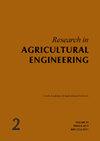Energy and exergy analyses of okra drying process in a forced convection cabinet dryer
Q3 Agricultural and Biological Sciences
引用次数: 11
Abstract
A forced convection automatic cabinet dryer integrated with a data logger was designed and fabricated. The okra samples were dried in the dryer at drying temperatures of 50, 60, and 70 °C and at three different load densities of 200, 300, and 400 g at a continuous air velocity of 0.7 m·s–1. Energy and exergy analyses of the drying process were performed. The obtained results showed that the energy efficiency, energy utilisation, and utilisation ratio increased from 26.59 to 68.24%, 5.47 to 114.36 W, and 0.36 to 0.71 as the temperature increased to 70 °C, respectively. The inflow, outflow, and exergy losses were in the range of 7.02 to 26.14 W, 4.43 to 14.16 W, and 2.59 to 11.98 W, respectively, while exergy efficiency varied from 49.15 to 63.47%. The findings show that exergy efficiencies decrease with an increase in the drying temperature, but increase with a lower load rate. The index of sustainability varies from 2.14 to 2.77, the value increases as the load density decreases while it decreases with a temperature increment.强制对流柜式干燥机中秋葵干燥过程的能量与火用分析
设计并制作了一种带数据记录仪的强制对流自动柜式干燥机。干燥温度分别为50、60、70℃,负载密度分别为200、300、400 g,连续风速为0.7 m·s-1。对干燥过程进行了能量和火用分析。结果表明,当温度升高至70℃时,能效、能量利用率和利用率分别从26.59 W增加到68.24%、5.47 W增加到114.36 W、0.36 W增加到0.71 W。流入损失为7.02 ~ 26.14 W,流出损失为4.43 ~ 14.16 W,火用损失为2.59 ~ 11.98 W,火用效率为49.15% ~ 63.47%。结果表明:干燥温度越高,火用效率越低,负载率越低,火用效率越高;可持续性指数变化范围为2.14 ~ 2.77,随荷载密度的减小而增大,随温度的升高而减小。
本文章由计算机程序翻译,如有差异,请以英文原文为准。
求助全文
约1分钟内获得全文
求助全文
来源期刊

Research in Agricultural Engineering
Engineering, agriculture-
CiteScore
1.40
自引率
0.00%
发文量
21
审稿时长
24 weeks
期刊介绍:
Original scientific papers, short communications, information, and studies covering all areas of agricultural engineering, agricultural technology, processing of agricultural products, countryside buildings and related problems from ecology, energetics, economy, ergonomy and applied physics and chemistry. Papers are published in English.
 求助内容:
求助内容: 应助结果提醒方式:
应助结果提醒方式:


